Forces Driving the Explosion in Enterprise Data Strategy
Most sectors are now engaged in transformation programs designed to reshape their business models by harnessing data’s immense potential. Investments in monetizing data for marketing, sales, service, and operations consistently deliver a higher ROI than alternative uses of capital.
The explosion of structured and unstructured big data over the past few years has prompted CEOs to get on the data monetization bandwagon, compounded by a dramatic drop in storage and processing costs, and increasing regulatory focus on data quality, policy, governance models, aggregation, metrics, reporting, and monitoring.
Becoming a Digital Champion
Leading institutions that once used only descriptive and diagnostic analytics to inform decision making are now embedding predictive and prescriptive analytics in products, processes, services, and multiple front-line activities. Where they once built relational data warehouses to store structured data from specific sources, they are now operating “data lakes” with large-scale distributed file systems that capture, store, and instantly update structured and unstructured data from a vast range of sources to support faster and easier data access.
Concurrently, “digital champions” are taking advantage of cloud technology to make their operations leaner and more efficient and drive agility and innovation. Most of these champions have set up a new unit under a chief data officer to run their data transformation and ensure disciplined data governance that converts raw data into revenue, service excellence, brand loyalty, and more efficient operations.
Digital transformation deployed correctly yields massive benefits. A U.S.-based financial services giant drove more than $400 million in savings by rationalizing its IT data assets, and $2 billion in gains from additional revenues, lower capital requirements, and increased operational efficiencies. A U.S.-based insurer expects to grow its bottom line by 25% in target segments and products, thanks to data-driven business initiatives.
Yet, despite these impressive gains from digital transformation investments, many other organizations still struggle to capture real value from their data programs, with some seeing scant returns from investments totaling hundreds of millions of dollars.
So, how do companies avoid these struggles and realize the impressive gains that others have? Answer: Develop an Enterprise Data Strategy (EDS) that serves as the core for your firm’s evolution to the data-driven enterprise of the future.
5 Guiding Principles
-
Define a clear data strategy
Define the guiding vision for your data transformation journey, design a strategy to transform the organization, and establish clear and measurable milestones.
-
Translate the data strategy into tangible use cases
Select a range of use cases and prioritize them in line with your goals, use top-priority use cases to boost internal capabilities, and start laying solid data foundations.
-
Design innovative data architecture to support the use cases
Define the technical support needed for your roadmap of use cases, and design a modular, open data architecture that makes it easy to add new components later.
-
Set up robust data governance to ensure data quality
Assess data quality, establish robust data governance with clear accountability for data quality, and provide self-service tools to facilitate data access across the whole organization.
-
Mobilize the organization to deliver value
Align organization and culture with new capabilities, communicate the incentives for empowering the digitally transformed enterprise, and train people to leverage the new digital capabilities.
Data Lakes – New Tech Helping Your Enterprise Data Strategy Succeed
The transformation era has given rise to new technologies that empower the new, digitally transformed operating model. Storing your data in data lakes is required to provide the access, flexibility, agility, and real-time analytics to monetize data.
A data lake is not a direct replacement for a data warehouse; they are supplemental technologies that serve different use cases with some overlap. Most organizations that have a data lake will also have a data warehouse, though another advantage to data lakes is that they can be less expensive to implement and operate.
The case for data lake implementation
| Data Lake | Traditional On-Premises Data Warehouse |
|---|---|
| Data stored in native format | Data requires transformation |
| Can store unlimited data forever | Expensive to store large volumes |
| Schema-on-read | Schema-on-write |
| Decoupled storage and compute | Tightly coupled storage and compute |
Businesses can use existing infrastructure to launch their data lake almost immediately by taking advantage of security, compatability, and accessibility features they already enjoy with Microsoft enterprise products in the case of Azure, or out-of-the box in the case of AWS and the Google Cloud Platform.
Everyone wants usable insights faster. The challenge isn't storing the data, it's accessing and analyzing the data. Companies are implementing data lake technologies in innovative ways that beat the competition to achieve success in transformation. By deploying and leveraging these capabilities today they are poised to be the digital champions of tomorrow.
Mapping the Path from Data Lake to Analytics

Copyright © 2021 Trianz
The Roadmap That Leads to Data Strategy
To create a well-grounded data strategy that will make data accessible and usable, organizations must address not only data storage, but also all the ways they acquire, access, share, manage and use data to support today's complex processing and decision-making demands.
There are six core components of a data strategy that work together as building blocks to support data management across an organization comprehensively. The roadmap resides in the first component, Vision/Strategy, and is a key element for obtaining executive sign-off and all departments' buy-in for a successful launch and implementation.
The Components of Enterprise Data Strategy Development

Copyright © 2021 Trianz
The core components explained:
1. Vision
A robust data strategy must start with a vision that includes a roadmap for the business strategy and people. Ask these questions:
- What is the problem you need to solve?
- What kind of data can help?
- How will the data be sourced?
- How will the data be stored and managed?
- What would be the method of analyzing the data?
- Who will be the data stakeholders?
- How will the data be shared across the team?
Once these driving principles are in place, a roadmap (it could be 1 year, 3-years, or 5-years) should be put in place, followed by the value proposition. As soon as the vision is laid out, organizations can then align it with the corporate, business, and IT goals.
Data Strategy Implementation Roadmap

Copyright © 2021 Trianz
2. Governance
With changes in technology, processing, and methodology, data governance provides the necessary rigor over the data content. It ensures that the data is managed consistently across the organization and that the decisions about how data is processed, managed, or shared aren't made by an individual; rather are derived from the rules and policies of data governance.
Most data governance initiatives are confined to specific project efforts. Effective data governance, however, must focus on three core elements:
- Program governance to address scope and budget
- Architectural governance to set and align to tech standards
- Data governance to drive the requirements and consistency
Our data says 80% of Digital Champions (companies who are successful in their digital transformation initiatives) are investing in data governance capabilities for a strong, scalable foundation before integrating data or building advanced analytics capabilities.
Data Governance – a Fundamental Investment

Copyright © 2021 Trianz
3. Organization
A data strategy should also include attention to capabilities, procedures, and organizational roles by documenting who does what with the data to facilitate collaboration and avoid duplication. Everyone uses data differently, and individuals' roles in data collection, management, and analytics will vary.
4. Business
An effective data strategy ensures that the business and IT jointly lead an organization's direction by understanding each other's needs, capabilities, and priorities. This will help organizations to adopt a "business-led or technology-enabled" approach.
So, the idea is to set in motion the unified goals, applications, and metrics and then make a case for business justification. The path to adoption of an integrated data strategy becomes more clear when there is visible value measurement. Data strategy must reinforce consistency in how initiatives are measured, evaluated, and tracked across all levels.
5. Data
The data requirements in data strategy essentially boil down to what data an organization will need and how it will be shared? An effective data strategy must identify the common themes and issues related to the data itself, such as data architecture, data movement, data quality, and data compliance.
Data architecture is perhaps the most important element of an organization's data strategy, and the first step is to determine what datasets exist among business units across the company. Data catalogs are useful tools for this purpose. After that comes data analysis, where data needs to be stored in a single repository, such as a data warehouse or data lake.
Finally, an organization must identify a data pipeline to ingest raw data from disparate sources and replicate it to a storage and analysis destination. All of these elements help ensure that the final solution delivers the right business requirements at the right time.
6. Technical
The data strategy must also address the technical aspects of data, such as the technical architecture, servers, storage, network, and scalability. Assessment and identification of technical architecture is the priority element here, followed by the definition and documentation of conceptual, technical architecture, and data flow. These functionality expectations are interdependencies to arrive at the best available capabilities.
The organization can then organize the resulting data strategy into an implementation strategy and roadmap that aligns with the six pillars as shown below.
Alignment of Framework to Data Strategy

Copyright © 2021 Trianz
Depending on corporate priorities, the new business capabilities created on the far right of the graphic can be either service, selling, marketing, or operational capabilities taken to the next level – i.e.,digitally transformed processes that are data-driven. This model represents the nexus of corporate strategy, data assets, and the digitally transformed business capabilities defined on the far right of the graphic.
Defining a Data Strategy is Key
A data strategy initiative isn't a one-and-done effort; rather, it must be a multi-year set of goals with a short-term set of delivery milestones. Most organizations have already invested in numerous data management initiatives, but they don't see much traction when they aren't aligned with one another.
A robust data strategy positions organizations to deliver the best possible solution as their needs grow and evolve. It also becomes a roadmap to address both existing and future data management needs.
Trianz has helped several companies organize, analyze, and leverage their data assets to secure an unbeatable competitive advantage.
How can an enterprise data strategy transform my organization?
Trianz has developed a toolkit complete with frameworks, designs, and technology alternatives to address today's toughest business challenges. Our approach to digital transformation ensures that every application, resource, and tool you use is an ideal fit for making strategic decisions that lead to greater business impact.
Experience the Trianz Difference
Trianz enables digital transformations through effective strategies and excellence in execution. Collaborating with business and technology leaders, we help formulate and execute operational strategies to achieve intended business outcomes by bringing the best of consulting, technology experiences, and execution models.
Powered by knowledge, research, and perspectives, we enable clients to transform their business ecosystems and achieve superior performance by leveraging infrastructure, cloud, analytics, digital, and security paradigms. Reach out to get in touch or learn more.

